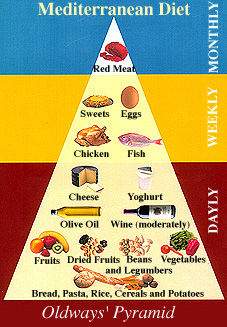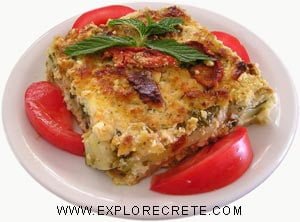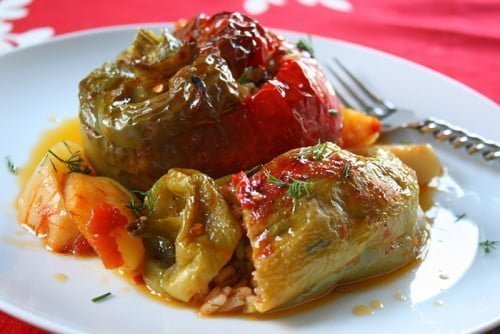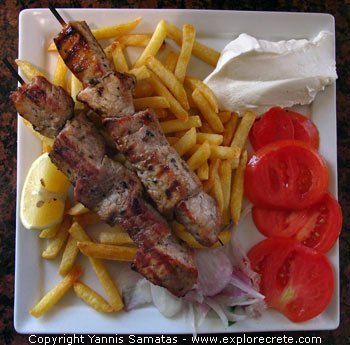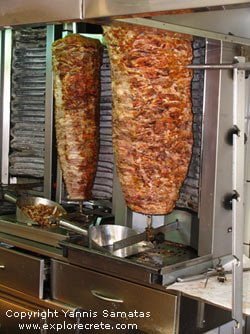Roots of Cretan Diet in Minoan Crete
Much has been written in recent years about the traditional Cretan diet, and it would be difficult to be in Crete for long without realising how valued the fresh local ingredients still are to local gourmets. And of course every Cretan is a gourmet by definition.
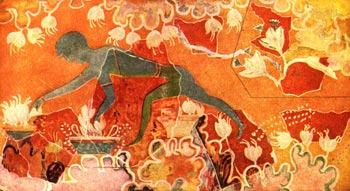
The general scorn for supermarket food among the indigenous population makes me wonder how they (ie the supermarkets!) survive. “Ochi supermarket !” seems to be the proud cry any time we sit down to eat in a Cretan home. Only the paper serviettes, we are assured, have been shop purchased. Tables groan with delicious dishes conjured from the local soil and hard labour. While English tables demand beans from Kenya, strawberries from Spain, and meat from New Zealand, the only airmiles required by the Cretan table are those travelled by bees.
The ancient roots of the traditional Cretan diet
But what do we mean by a “traditional” Cretan diet? I have been fascinated by some recent discoveries about not only the history, but the prehistory of eating on this fertile island. We all know the term “a land flowing with milk and honey” and the word “cornucopia” (horn of plenty) to describe the idea of abundance. Both these terms are associated with ancient Crete, for it was here that the baby god was fed milk from a wild goat”s horn by the Goddess Amaltheia, and honey by the bee Goddess Melissa.
But science as well as myth can now vouch for the ancient roots of the abundance that we still enjoy when we sit down to eat a traditional Cretan meal. Recent developments in DNA analysis has allowed researchers to reveal fascinating details about what the original inhabitants of Knossos and other Minoan settlements had for dinner, and even the tipples they washed it down with!
By scraping the inside of vessels and cooking pots up to 5,000 years old, they have revealed an array of dishes that would be remarkably at home on a taverna menu today. For instance, they have found that to make stews, meat was first roasted before being stewed with green vegetables. This is a method I have only seen in Cretan kitchens.
Other refinements they have discovered from the astonishingly sophisticated civilisation of around 2,000BC are herb-flavoured milk, olive oil flavoured with saffron, and – yes, you’ve guessed, retsina! Drinking vessels found in the settlement at Myrtos were found to contain resinated wine, and what”s more, it was toasted oak that had been used to flavour the wine! Tell that to the waitor next time you”re served up with a vinegary retsina!
The Minoan wine list seems to have been at least as varied as it is today, with barley beer, mead (wine sweetened with honey), and herb-flavoured wines being enjoyed. Even more incredible, not all the ingredients were local. Some of the resin was found to be copal resin from Africa, and terebinth resin was found in Palestinian wine jars in a late Minoan shipwreck off the coast of Crete. Further evidence that the Minoans were the most adventurous traders of the ancient world!
The Minoan Diet of Crete
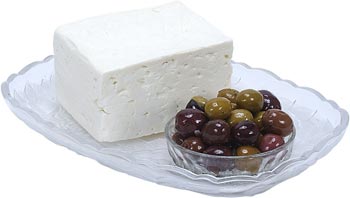
But what were the staples of the ancient Minoan diet ? Well, remarkably familiar ones, it seems. Olives, of course, then as now, were what the reindeer is to the eskimos: essential for food, medicine, cosmetics, light and heat. Meat came from sheep, goats, pigs, and cattle: all originally indigenous wild varieties. Deer were also eaten as was other game. Just as today, a wide variety of pulses were grown and cooked, including peas, lentils, fava beans, broad beans, field beans, and chick peas (what, no gigantes?!)
And of course the huge variety of vegetables still known as horta, or wild vegetables today: wild artichoke, asparagus, chicories and endives, radish, wild leeks, wild mustard, saw thistles, purslane, vetches, okra, and many of the bulbs still prized as healthy vegetables and seen in today”s markets.
Grains are not prominent crops today, although the corn circles used to thresh grain until recent times are everywhere. But in 3,000 BC there were at least three kinds of wheat as well as barley and rye grown. Modern farmers interested in catering for the health conscious market might note an opportunity here, for early relatives of modern wheat such as so-called spelt wheat, are now known to be healthier as they contain less gluten and don”t trigger the allergies that normal wheat can.
Some of today’s staples were not present. Tomatoes did not arrive here until the 19th century, and potatos, bananas and avocados are all quite recent. It has been reported that in the 17th century there were 40 kinds of grapes and as many varieties of olive. In the same period, 29 varieties of wild herbs or vegetables were recorded by the traveller and writer George Sands, who observed that people then lived on these greens almost exclusively for 8 months of the year! That”s a long cleansing diet! However by 1812 another writer spoke of rice and baclava, so decadence was setting in again, at least for some!
In my next article, I will look at fragmentary evidence for some of the medicines that were used in ancient Crete. And I will reveal the precious, mysterious substance that was so valuable that it may have been what stimulated the Minoan economy to flourish so prodigiously and leave such a uniquely rich cultural and artistic heritage.
Cora Greenhill
April 2005
Who is Cora Greenhill? Cora Greenhill lives in Crete and UK, working as a writer and artist, and teaching Gabrielle Roth”s “5Rhythms dancework” -Cora”s website is at http://www.thirteenthmoon.co.uk
© explorecrete.com All Rights Reserved. Reproduction or copying without permission is prohibited.

